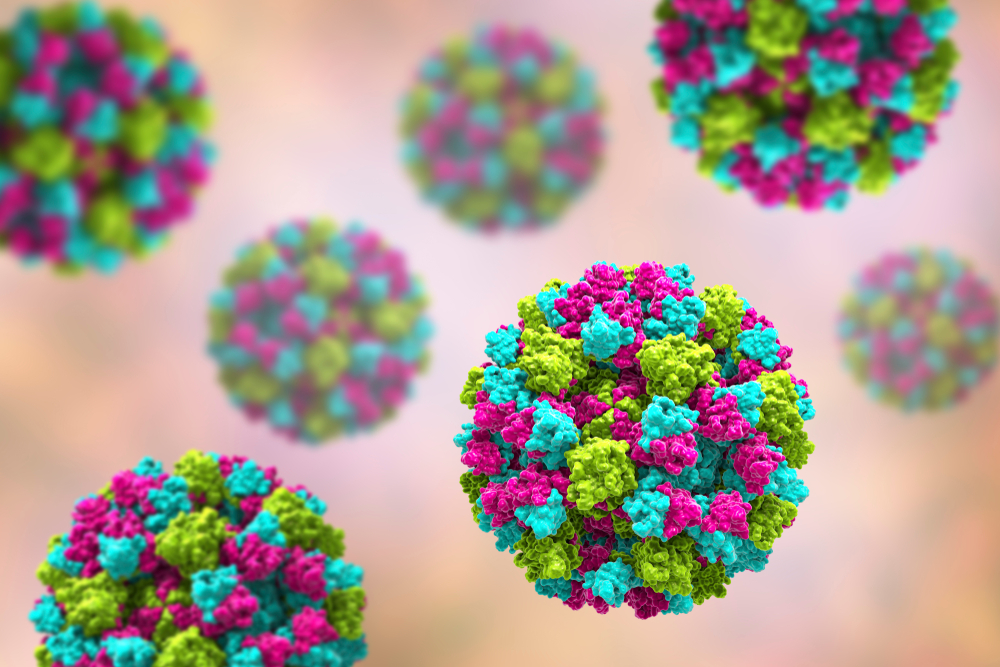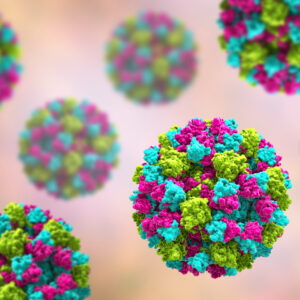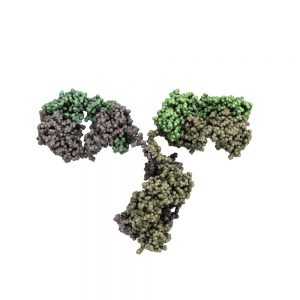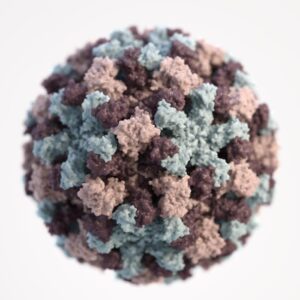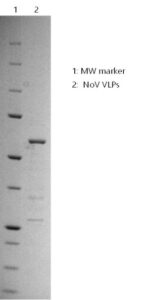
SDS-PAGE: Reducing SDS-PAGE gel showing purified Norovirus VLPs, showing protein migrating as a band of approximately 60kDa.
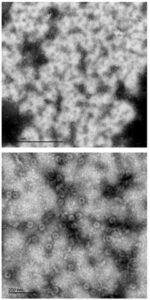
Electron Micrograph: EM image of Norovirus GII.6 virus-like particles.
Norovirus GII.6 VLP
Price range: $498.20 through $1,757.31 excl. VAT
Recombinant Norovirus GII.6 VP1 Virus-Like Particles (VLP) produced in mammalian HEK293 cells. Norovirus VP1 structural protein is transiently expressed to form a particle without the non-structural proteins or genome. Resultant particles are totally non-infectious.
NOROVIRUS GII.6 VLP
Norovirus VP1 protein is the capsid protein of Norovirus. It is a 59kD glycoprotein with three key domains. The shell domain (S domain) contains elements essential for the formation of the icosahedron. The Protruding domain (P domain) is divided into sub-domains P1 and P2. P domain interacts in dimeric contacts that increase the stability of the capsid and form the protrusions on the virion. A hypervariable region in P2 is thought to play an important role in receptor binding and immune reactivity.
The Norovirus VP1 protein self-assembles to form the Norovirus virion, containing 180 copies of the protein. The Native Antigen Company produce VP1 protein in a mammalian cell expression system, which produces intact virus-like particles (VLPs) of very high purity. These VLPs are suitable for studies of VP1 structure, and also as potential targets for serological assays.
PRODUCT DETAILS – NOROVIRUS GII.6 VLP
- Recombinant Norovirus GII.6 virus-like particles comprising VP1 protein expressed from HEK293 cells (NCBI Accession Code: QJF54142.1).
- Includes amino acids 1-547 and presented as liquid in proprietary buffer.
- Greater than 85% purity by SDS-PAGE.
BACKGROUND
Norovirus (NoV) is a small non-enveloped, positive-sense RNA virus belonging to the Caliciviridae family of viruses. Six norovirus genogroups have been identified to date, which are further subdivided into genotypes. NoVs have a high mutation rate and numerous genotypes have been identified. NoVs responsible for human disease are found within genogroups GII, GI and GIV. The variant GII.4 has been identified as the most common cause of Norovirus outbreaks since 2002. (Karst, S.M.).
Previously known as Norwalk virus, NoV is a major cause of non-bacterial outbreaks of acute gastroenteritis worldwide. Norovirus can infect individuals of all ages and can be a major cause of gastroenteritis in schools, care-homes, hospitals and cruise ships. Symptoms of NoV infection develop rapidly and include vomiting, nausea, abdominal cramps and diarrhoea (Robilotti, E. et al). In most cases, Nov infection is a self-limiting disease that may last 1- 3 days but can cause complications in very young, elderly and immunocompromised individuals. In some severe cases, NoV infection can result in dehydration, hospitalisation and death. (CDC).
NoV is highly contagious. It can persistent in the environment and is resistant to most household disinfectants. Transmission of NoV primarily occurs through the faecal oral route and through contact with infected individuals, contaminated clothing, surfaces, food and water. In the USA, NoV is the major cause of food related illness. (CDC).
REFERENCES
- Karst SM. (2010). Pathogenesis of noroviruses, emerging RNA viruses. Viruses.Mar;2(3):748-81. PMID: 21994656
- Robilotti E, Deresinski S, Pinsky BA. (2015). Norovirus. Clin Microbiol Rev.Jan;28(1):134-64. PMID: 25567225
- Centers for disease control and prevention: Norovirus, Clinical overview
- Centers for disease control and prevention: Norovirus, Burden of norovirus illness and outbreaks
- Takeda press release: Takeda initiates world’s first norovirus vaccine field trial

